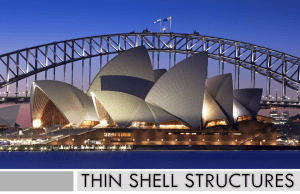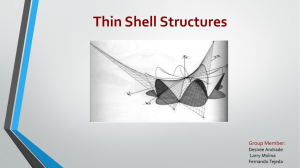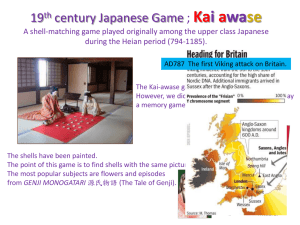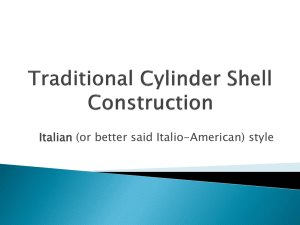Shells and domes
advertisement
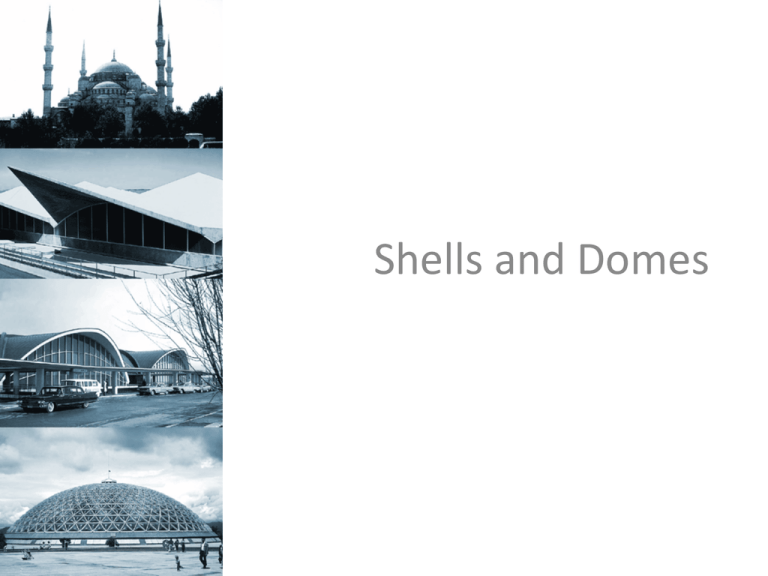
Shells and Domes SHELLS • Shell is a type of building enclosures. • Shells belong to the family of arches . They can be defined as curved or angled structures capable of transmitting loads in more than two directions to supports. • A shell with one curved surface is known as a vault (single curvature ). • A shell with doubly curved surface is known as a dome (double curvature). Classification of shells • There are many different ways to classify shell structures but two ways are common: 1. The material which the shell is made of: like reinforced concrete, plywood or steel, because each one has different properties that can determine the shape of the building and therefore, these characteristics have to be considered in the design. 2. The shell thickness: shells can be thick or thin. Thin Concrete Shells The thin concrete shell structures are a lightweight construction composed of a relatively thin shell made of reinforced concrete, usually without the use of internal supports giving an open unobstructed interior. The shells are most commonly domes and flat plates, but may also take the form of ellipsoids or cylindrical sections, or some combination thereof. Most concrete shell structures are commercial and sports buildings or storage facilities. There are two important factors in the development of the thin concrete shell structures: • The first factor is the shape which was was developed along the history of these constructions. Some shapes were resistant and can be erected easily. However, the designer’s incessant desire for more ambitious structures did not stop and new shapes were designed. • The second factor to be considered in the thin concrete shell structures is the thickness, which is usually less than 10 centimeters. For example, the thickness of the Hayden planetarium was 7.6 centimeters. Types of Thin Concrete Shells 1. Barrels shells The cylindrical thin shells, also called barrels, should not be confused with the vaults even with the huge similarity in the shape of both structures, because each of these structures has a different structural behavior as well as different requirements in the minimum thickness and the shape. • On one hand, the structural behavior of the vault is based on connected parallel arches, which transmit the same effort to the supports . Therefore, the materials used in these structures have to be able to resists compressions (e.g. stone) and the thickness is usually higher. Furthermore, the shape of the vaults must be as similar as possible to the arch in order to achieve the optimum structural behavior. • On the other hand, the structural behavior of the barrels shell is that it carries load longitudinally as a beam and transversally as an arch. and therefore, the materials have to resist both compression and tension stresses. This factor takes advantage of the bars of the reinforced concrete, because these elements can be placed where tension forces are needed and therefore, the span to thickness Ratios can be increased. Furthermore, the shape has fewer requirements than the vaults and therefore, new curves like the ellipse or the parabola can be used improving the aesthetic quality of the structure. Types of Thin Concrete Shells 2. Folded plate A thin-walled building structure of the shell type. Advantages of Folded Plate Roofs over Shell Roofs are: (a) Movable form work can be employed. (b) Form work required is relatively simpler. (c) Design involves simpler calculations. Disadvantages of Folded Plate Roofs over Shell Roofs are: (a) Folded plate consumes more material than shells. (b) Form work may be removed after 7 days whereas in case of shells it can be little earlier. Folded plate types Folded Plates system Folded-Plate Hut in Osaka Folded Plates Library Types of Thin Concrete Shells 3. Hyperbolic Paraboloid (Hypar) A Hypar is a surface curved in two directions that can be designed as a shell or warped lattice. A hypar is triangular, rectangular or rhomboidal in plan, with corners raised to the elevation desired for use and/or appearance. The edges of Hypars are typically restrained by stiff hollow beams that collect & transfer roof loads to the foundations. Rhomboid Types of shells 4. Various Double Curvature Types of Thin Concrete Shells 5. Dome A rounded roof, with a circular base, shaped like an arch in all directions.. First used in much of the Middle East and North Africa whence it spread to other parts of the Islamic world, because of its distinctive form the dome has, like the minaret, become a symbol of Islamic architecture. Dome has double curvature and the resulting structure is much stiffer and stronger than a single curved surface, such as a barrel shell. Types of Thin Concrete Shells 6. Translation Shells A translation shell is a dome set on four arches. The shape is different from a spherical dome and is generated by a vertical circle moving on another circle. All vertical slices have the same radius. It is easier to form than a spherical dome. • Advantages of Concrete Shells The curved shapes often used for concrete shells are naturally strong structures, allowing wide areas to be spanned without the use of internal supports, giving an open, unobstructed interior. The use of concrete as a building material reduces both materials cost and the construction cost, as concrete is relatively inexpensive and easily cast into compound curves. • Disadvantages of Concrete Shells Since concrete is porous material, concrete domes often have issues with sealing. If not treated, rainwater can seep through the roof and leak into the interior of the building. On the other hand, the seamless construction of concrete domes prevents air from escaping, and can lead to buildup of condensation on the inside of the shell. Shingling or sealants are common solutions to the problem of exterior moisture, and ventilation can address condensation. References • • • • • • The constructor.com Kth.diva-portal.org Nisee.berkeley.edu Faculty.ksu.edu.sa Arab-eng.org 219 design.som Done By : Abeer Al-Garni Abrar Al-Amri Bedor Maryam Hamzy
